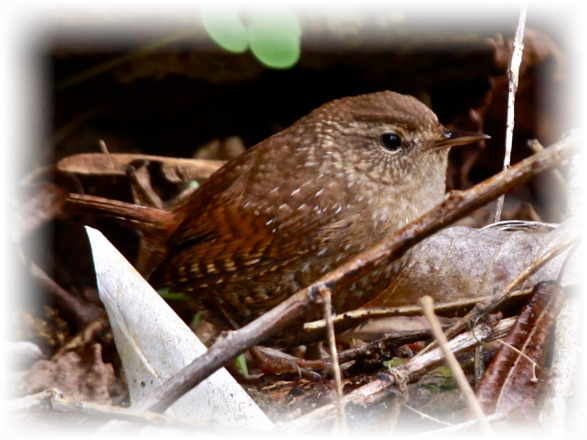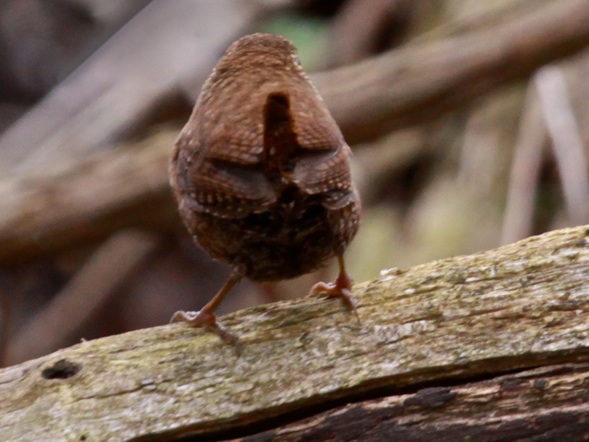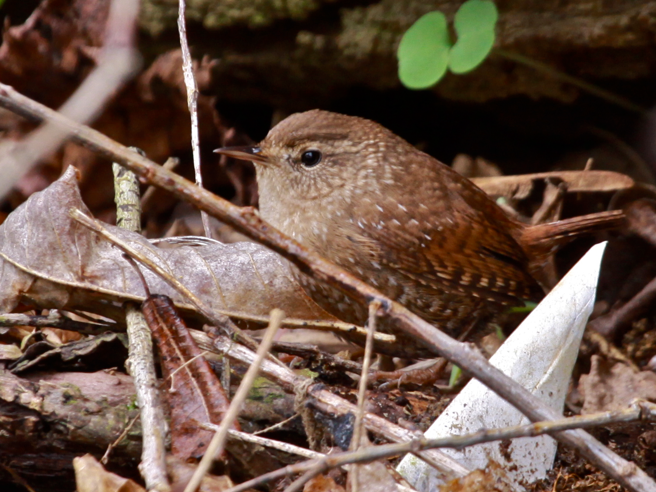The Nature
Observer’s Journal
The Nature
Observer’s Journal

The Wren, the Wren, the King of All Birds
Chuck Tague
The Wren, The Wren, the king of all birds,
On St. Stephen's Day got caught in the furze,
So its up with kettle and down with the pan,
Give me a penny to bury the Wren.
Encountering a Winter Wren in December is like finding a bit of magic in the bleak winter woods. A tiny bird, rich in the earthy colors of the forest and vibrant with boundless energy, a quick glimpse is all you get before this mysterious little bird with its high-cocked stubby tail disappears under a pile of brush or into exposed roots and crevices along an eroded stream bank. Solitary and secretive, its scientific name Troglodytes hiemalis means the winter cave dweller.
One of the smallest of all songbirds at four inches long, its voice is pure. Its song is sustained and extraordinarily loud. Named the Winter Wren because some hardy individuals remain all year in its breeding ground in the northern spruce-fir forests and in the high Appalachians, the vast majority of the Winter Wrens migrate. They move into the low country of western Pennsylvania in mid October, as if to replace the House Wren, a common summer resident. Some remain until late April when the House Wren returns.
The first Winter Wren I encountered spent December in a wooded ravine near my home in Banksville, near Pittsburgh. I spent many hours searching for it along a small stream. Mostly I caught quick glimpses of it disappearing into an undercut or a brush pile, but once I startled it as it probed along the ground where a small spring flowed from the hillside. It flew up the steep slope and perched on a root. It watched me for a few seconds, its head bobbing constantly, then dropped into a tangled maze of roots and rocks.
I waited, watching intently for it to come out but it never did. I climbed up and searched the tiny nooks and crannies to no avail. How it escaped without me seeing it I'll never know.
For many years, I participated in the Christmas Bird Count at Raccoon Creek State Park, Beaver County, PA. Before the count I went to the park to scout. I walked along the edges of streams, probing the snags, roots and shale outcroppings for an elusive wren.

As I hunted the wren on those cold December days, I was taking part in a tradition that my ancestors in Ireland have been following since the Middle Ages.
In many parts of Europe, on St. Stephen's Day, the day after Christmas, the men and boys go on a wren hunt. There are many explanations for this tradition. One says that as the martyr St. Stephen was about to escape from his captors, a wren landed on a drum, waking his guards. Another says that the Irish army was about to launch a surprise attack, but a singing wren woke the Danish invaders and their plan failed.
The wren hunt was mostly ceremonial, posing no real danger to the birds, and for the rest of the year the energetic little singer, Jenny Wren, was in everyone’s good favor.
In some rural parts of Ireland the tradition continues, often with much ceremony. On St. Stephen's Day the wren boys dress in women's clothes and move from house to house, asking for money and treats to "bury the Wren," singing The Wren Song as they go.
The wren, the wren, the king of all birds . . .
Around the world there are about 80 species of wrens, family Troglodytidae. They range from North Africa through Eurasia, North America and South America. Most of the species can only be found in the American Tropics. Ten breed in North America. In the entire Eastern Hemisphere there is only one species of wren, "Troglodytes troglodytes." Until recently it was considered the same species as our Winter Wren. (In 2010 the American Ornithologists’ Union split the Winter Wren, T. hiemalis, and the Pacific Wren, T. pacificus, from the European species.)
In the British Isles, it is known simply as the Wren, or affectionately as little Jenny Wren. While nowhere in North America is the Winter Wren found in great numbers, in Europe and Asia the Wren is as common and familiar as our House Wren. It is an important part of folklore and tradition.
The wren is truly a king among birds. It appears in southwestern Pennsylvania only when the sky turns gray and leaves begin to fall. It lives in magic castles along the forest floor and rules a kingdom of unseen subjects. Magic abounds where the Winter Wren is found. Long live the king.

Winter Wren, Magee Marsh, OH, May 6, 2011
* Read more about the Winter Wren’s incredible song on Lang Elliott’s The Music of Nature website.
Monday, December 26, 2011
